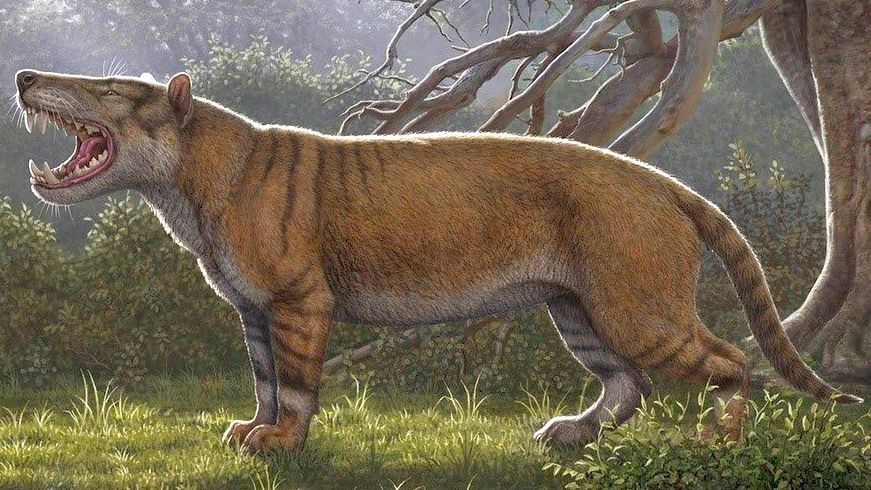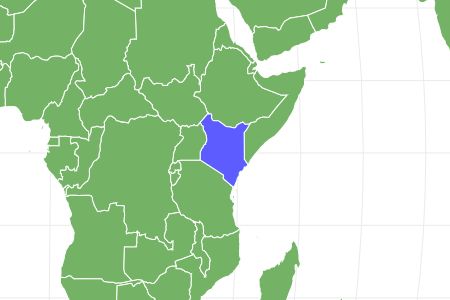Simbakubwa kutokaafrika was as big as a polar bear.
Advertisement
Simbakubwa Scientific Classification
- Kingdom
- Animalia
- Phylum
- Chordata
- Class
- Mammalia
- Order
- Hyaenodonta
- Family
- Hyainailouridae
- Genus
- Simbakubwa
- Scientific Name
- Simbakubwa kutokaafrika
Read our Complete Guide to Classification of Animals.
Simbakubwa Conservation Status
Simbakubwa Facts
- Prey
- Ancient rhinoceros and elephants
- Fun Fact
- Simbakubwa kutokaafrika was as big as a polar bear.
- Most Distinctive Feature
- Simbakubwa had 3 pairs of meat-slicing teeth
- Other Name(s)
- Great lion of Africa
View all of the Simbakubwa images!
Simbakubwa was an enormous lion-like carnivore that ruled in Kenya about 22 million years ago. Despite the name and lion-like appearance of this ancient mammal, it was not a member of the cat family. Instead, it belongs to an extinct group of carnivores known as the hyaenodonts. The hyaenodonts are among the largest terrestrial carnivores to have ever lived, and the Simbabukwa was among the largest of them.
Description and Size

Only one species of Simbakubwa,
Simbakubwa kutokaafrika, is known.
©Mauricio Anton/Wikimedia Commons – License
Simbakubwa is an extinct genus of carnivorous mammals of the family Hyaenodonta. Only one species, Simbakubwa kutokaafrika, is known to scientists. The specific name is a Swahili word that translates as “big lion from Africa.” Interestingly, the Simbakubwa was not related to the lion or any of the present-day big cats. Instead, it is a member of an extinct group of mammals known as the hyaenodonts.
The hyaenodonts had a dentition similar to that of the hyenas. Unlike lions and other feline canines with one pair of meat-slicing teeth, the hyaenodonts had three pairs. Interestingly, despite sharing a similar dentition to the hyena, the Simbakubwa is not related to them either.
Because the mammal is known from partially-preserved skull remains, it has been a little difficult to estimate its exact size. Scientists often quote a range of sizes for the Simbakubwa. The lowest estimate puts its weight at about 620 pounds, which is comparable to the size of modern-day lions. However, less conservative estimates suggest that the Simbakubwa would have reached weights of up to 3,300 pounds. This means it was more similar in size to present-day polar bears.
Diet – What Did Simbakubwa Eat?
The Simbakubwa was a hypercarnivore. This means it got most of the calories it needed from eating meat. A massive beast and specialist hunter, the Simbakubwa was an apex predator in its time. It preyed on various creatures that lived on the African continent at the time, such as the anthracotheres, a bigger relative of present-day rhinoceroses, and ancient elephants like the long-tusked Zygolophodon.
Habitat – When and Where It Lived
Simbakubwa lived in East Africa, in present-day Kenya, during the early Miocene epoch. Locals unearthed Fossils of this giant carnivore in the western region of Kenya. Scientists believe that this ancient “great lion” was one of the first carnivorous mammals on the African continent, and it ruled the continent in isolation for several million years. Eventually, as the continents continued to drift, the African plate got closer to other continents, allowing other carnivore species to disperse into Africa.
Threats and Predators
The great lion was an apex predator in its time. It faced no threat from any other animal species living alongside it. The lack of competition allowed the Simbakubwa to thrive for several years without disturbance from other species.
Discoveries and Fossils – Where Simbakubwa Was Found
Native Kenyans discovered the first fossils of Simbakubwa at the Meswa Bridge in Western Kenya. The find included:
- A mandible from the lower jaw.
- A right upper maxilla.
- A few postcranial bones.
However, they left the fossils in a Museum in Kenya for several decades. Years later, Matthew Borths and Nancy Stevens discovered the fossils and published a detailed description. By studying the wear patterns on the well-preserved teeth, they could determine that the fossil was from a young adult. The postcranial bones also provided some insights into the possible walking stance of this carnivore.
Extinction – When Did Simbakubwa Die Out?
The Simbakubwa lived about 20 million years ago during a period of massive ecological change. The continents of Africa were drifting closer to Eurasia, allowing a mix of species across the continents. Despite being among the largest predators on both continents, the massive hypercarnivore was slow to adapt to changes and must have died off due to rapid environmental disruption about 5 million years ago.
Asides from the introduction of new species, the connection of the two continents would have caused major climatic changes, including a change in precipitation patterns that would have transformed their native habitat from forest lands to a more open and grassy landscape. Prey animals would have adapted to these climatic changes, making it difficult for predators like the Simbakubwa to survive.
Similar Animals to The Simbakubwa
Similar animals to the Simbakubwa include:
- Apterodon: This was a hyaenodonts that lived in Africa and Europe from the late Eocene till the middle Oligocene epoch. They were semi-aquatic and were most notable for their digging ability.
- Limnocyonidae: Also known as the swamp dogs, members of this family of predatory mammals lived in North America and Asia. They belong to the same order as the Simbakubwa and lived from Paleocene to the late Eocene.
- Machairodontinae: This is a sub-family of carnivorous mammals famously known as the saber-tooth cat. The group was widely distributed across various continents worldwide and was among the most prolific predators in their habitats.
Related Animals
View all 293 animals that start with SSimbakubwa FAQs (Frequently Asked Questions)
When was the Simbakubwa alive?
Simbakubwa lived in the western part of modern-day Kenya about 23 million years ago. This was during the early Miocene epoch, a time characterized by major changes in mammalian populations.
How big was Simbakubwa?
Scientists often quote a size range of 620 pounds to 3,300 pounds. For the Simbakubwa. The incomplete nature of the animal’s fossil made it difficult to give an exact estimate of the animal’s size. However, based on the maximum size estimate, it was roughly the same size as a polar bear.
What does the full name Simbakubwa kutokaafrika mean?
“Simbakubwa kutokaafrika” means “big lion from Africa” in Swahili. Interestingly, despite the name, this giant carnivore was not related to the lions or any of the living big cats.
Thank you for reading! Have some feedback for us? Contact the AZ Animals editorial team.
Sources
- Newsweek, Available here: https://www.newsweek.com/prehistoric-enormous-big-lion-simbakubwa-1399058
- Wikipedia, Available here: https://en.wikipedia.org/wiki/Simbakubwa
- Discover Magazine, Available here: https://www.discovermagazine.com/planet-earth/simbakubwa-mega-carnivore-hiding-in-a-museum-drawer

















